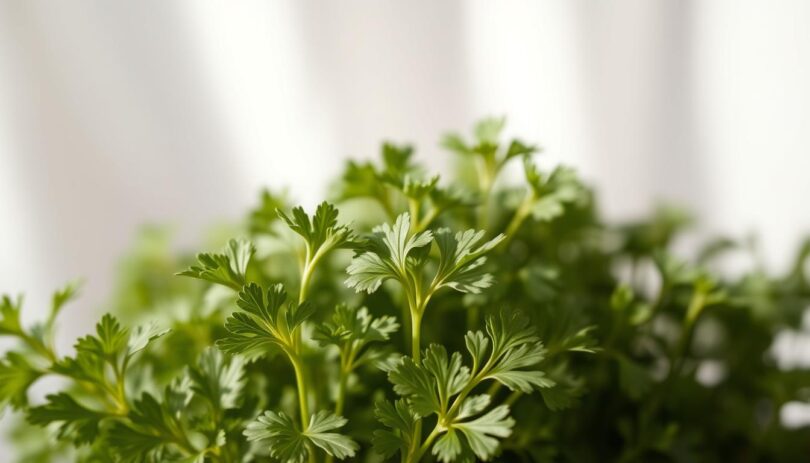Is that fresh herb in your kitchen safe for your furry friend? While many pet owners focus on meat-based snacks, leafy greens like cilantro often spark curiosity—and confusion. Understanding what’s healthy for pets requires balancing expert insights with real-world practicality.
Veterinarians confirm that cilantro isn’t toxic to canine companions. However, its strong flavor might not appeal to every pet. Some animals turn up their noses at first sniff, while others enjoy it mixed into meals. Moderation remains key, as with any addition to a balanced diet.
This herb offers vitamins A, C, and K, which support immune health and digestion. It may even freshen breath naturally. But before sprinkling it on kibble, consider portion sizes and preparation methods. Always prioritize high-quality pet food over human treats.
Dr. Jerry Klein, a leading veterinary expert, emphasizes gradual introduction when testing new foods. This article explores safe practices, nutritional perks, and potential risks—helping you make informed choices for your four-legged family member.
The Nutritional Benefits of Cilantro for Dogs
Packed with vitamins and minerals, this leafy green offers more than just flavor. Its nutrient profile supports multiple aspects of a pet’s wellness, from bone strength to immune function. Let’s explore how small additions can make a meaningful difference.
Key Vitamins and Minerals in Cilantro
Rich in vitamin A, cilantro promotes healthy vision and skin. Vitamin C boosts immunity, while vitamin K aids blood clotting. Calcium and magnesium work together to maintain strong bones and muscles—a bonus for active pets.
Enhancing Skin, Fur, and Overall Health
The antioxidants in this herb help combat free radicals, supporting glossy coats and reducing inflammation. For picky eaters, mixing finely chopped leaves into regular meals adds variety without overwhelming their palate. Unlike some safe herbs for pets, it’s gentle on sensitive stomachs when introduced slowly.
While not a substitute for balanced meals, cilantro complements protein-rich diets. Try blending it into homemade treats or sprinkling over steamed vegetables. Always consult your vet before making dietary changes to ensure alignment with your companion’s unique needs.
Risks and Considerations When Feeding Cilantro
Introducing new foods to pets requires awareness of possible adverse effects. Though non-toxic, this herb demands thoughtful portioning to avoid discomfort. Monitoring reactions helps balance curiosity with safety.
Potential Gastrointestinal Upset
Overfeeding may lead to gastrointestinal upset in sensitive animals. Symptoms like loose stools or vomiting often signal digestive strain. Stems can be particularly tough to break down, so stick to chopped leaves.
Dr. Sarah Wooten notes, “Start with a pinch mixed into meals. Watch for changes in appetite or energy.” Smaller breeds might need half the portion size of larger companions. Always prioritize their regular diet over experimental treats.
Recognizing Allergic Reactions and Sensitivities
Allergies to herbs are rare but possible. Look for itching, redness around the mouth, or sudden lethargy. If these occur, remove the herb and consult a veterinarian promptly.
Persistent symptoms like swelling or difficulty breathing require immediate attention. Keep portions tiny during initial trials—no more than 1/4 teaspoon for a medium-sized dog. Remember: every pet’s tolerance varies, so patience is key.
Can Dogs Have Cilantro? Safety Facts
Portion control plays a critical role when offering herbs to pets. Moderation means treating cilantro as an occasional add-on—never exceeding 10% of daily calories. For a 30-pound companion, this translates to roughly 1-2 teaspoons of fresh, chopped leaves weekly.
Tailoring Servings to Size and Needs
Small breeds like Chihuahuas thrive with pea-sized amounts, while larger breeds may handle a tablespoon. Always remove stems to reduce choking risks. Veterinary nutritionist Dr. Lisa Freeman advises, “Treat herbs like spices—use sparingly to enhance meals, not dominate them.”
When Flavors Don’t Click
Just as humans dislike certain foods, pets may reject cilantro’s earthy taste. Try mixing minced leaves into pumpkin puree or scrambled eggs. If they walk away, don’t force it—other greens like parsley might suit their palate better.
Remember: cilantro complements balanced meals but shouldn’t replace them. Start with a single leaf to gauge tolerance. This approach keeps snacks exciting without compromising nutritional priorities.
How to Safely Integrate Cilantro into Your Dog’s Diet
Introducing new flavors to pets can be exciting but requires careful planning. Follow these vet-approved steps to add variety while prioritizing safety and nutrition.
Proper Preparation and Portioning
Start by washing fresh cilantro thoroughly under cool water to remove dirt or pesticides. Remove stems and finely chop leaves to reduce choking hazards. Mix a pinch (about 1/8 teaspoon for small breeds) into their regular food once weekly.
Portion sizes should never exceed 10% of daily calories. For homemade treats, blend minced leaves with dog-safe ingredients like pumpkin or plain yogurt. Always consult your veterinarian before altering meals, especially for pets with dietary restrictions.
Methods to Introduce Cilantro Gradually
Begin with a single leaf mixed into wet food or broth. Observe for 48 hours for signs of stomach upset or allergic reactions. If tolerated, slowly increase to 1-2 teaspoons weekly for medium-sized companions.
Pair the herb with familiar flavors like cooked chicken or rice to encourage acceptance. Skip it entirely if your pet shows disinterest—plenty of other greens offer similar benefits. Regular monitoring ensures this addition remains a positive experience.
Alternative Dog-Friendly Foods and Treats
Expanding your companion’s menu with wholesome ingredients keeps meals interesting and nutritious. While cilantro works for some pets, dozens of other herbs and vegetables offer similar benefits without strong flavors. Variety helps prevent boredom while delivering essential nutrients.
Exploring Other Safe Herbs and Vegetables
Parsley and basil provide vitamins A and K like cilantro but with milder tastes. Carrots add crunch and beta-carotene, supporting eye health. Green beans are fiber-rich and low-calorie—ideal for weight management.
Dr. Angela Martin, a veterinary nutritionist, recommends rotating ingredients: “Alternate between spinach, zucchini, and cucumbers to diversify nutrient intake.” Always steam or chop raw veggies for easier digestion. Avoid onions, garlic, and chives, which are toxic even in small amounts.
For treats, blend blueberries with plain yogurt or bake sweet potato bites. These options supply antioxidants and fiber. Introduce one new food weekly, watching for stomach upset. If loose stools occur, scale back portions.
Remember: every pet has unique preferences. Some relish chopped broccoli florets, while others prefer apple slices. Pair new items with familiar proteins like turkey or salmon to encourage tasting. Keep additions under 10% of daily calories to maintain dietary balance.
Wrapping Up: Best Practices for a Healthy Dog Diet
Balancing variety and safety in your pet’s meals starts with informed choices. Fresh cilantro offers vitamins and antioxidants but requires careful portioning. Always prioritize moderation—a few chopped leaves weekly can enhance meals without disrupting nutritional balance.
Every companion has unique preferences. Some enjoy earthy herbs, while others avoid them. Introduce new foods slowly, watching for digestive changes or allergic reactions. Consult your veterinarian to align treats with dietary needs.
Remember these essentials: wash herbs thoroughly, remove stems, and start with tiny amounts. Pair cilantro with familiar proteins or vegetables to encourage acceptance. If your pet dislikes it, try parsley or basil instead.
A balanced diet remains the foundation of long-term health. Use natural supplements sparingly, and never replace meals with human foods. Have questions? Share them below—our community and experts are here to help!
FAQ
Is cilantro toxic to pets?
No, cilantro isn’t toxic when served in moderation. However, overfeeding may lead to mild digestive issues like gas or loose stools. Always consult your vet before adding new foods.
What nutrients does cilantro provide for canine health?
This herb contains vitamins A, C, and K, plus antioxidants like beta-carotene. These support immune function, skin health, and coat shine. Introduce small amounts to avoid overwhelming sensitive stomachs.
How much cilantro can I give my pet?
Start with ¼ teaspoon of chopped leaves per 10 pounds of body weight. Monitor for reactions like itching or vomiting. Adjust portions based on tolerance and your vet’s advice.
Are there safer alternatives to cilantro for picky eaters?
Parsley, basil, or steamed carrots offer similar benefits. Brands like The Honest Kitchen and Blue Buffalo also sell herb-infused treats formulated for pets.










Leave a Comment